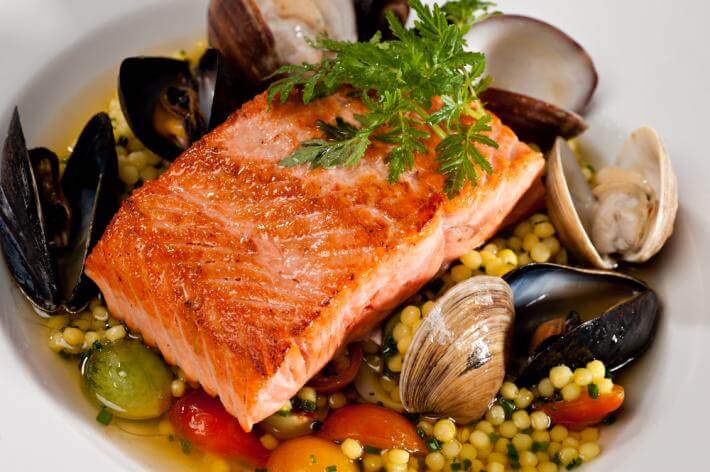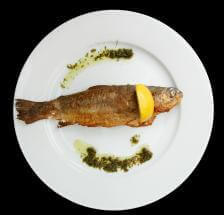Farm-Raised vs. Wild-Caught Fish
From nutrition to sustainability to cost to contaminants, there’s a lot to consider when weighing the pros and cons of farm-raised vs. wild-caught fish. Nutrition Diva sorts through the confusion.
Monica Reinagel, MS, LD/N, CNS

Listen
Farm-Raised vs. Wild-Caught Fish
Just about everyone I know is trying to eat more fish these days. Eating at least two servings of fish or shellfish per week appears to reduce the risk of heart disease, delay the onset of Alzheimer’s and dementia, and (if you’re pregnant) make your baby smarter and healthier.
Although meat, poultry, and fish are all good sources of protein, seafood boasts the healthiest fatty acid profile: it’s low in saturated fat and high in those omega-3 fats we hear so much about.
When you get to the fish counter, however, you’ve got some decisions to make. In particular: should you buy wild-caught or farm-raised fish? Many assume that wild-caught fish must be a lot better for you because it’s more “natural.” But it this necessarily the case? And what about environmental issues, food safety, sustainability, and cost? With this many factors to consider, it’s impossible to make a blanket recommendation. Choosing between wild-caught and farm-raised fish depends on what kind of fish you’re buying, as well as where and how it is fished (or farmed).
Is Wild-Caught Fish More Nutritious?
Today’s farmed Atlantic salmon provide significantly more omega-3 fats than wild-caught.
The nutritional differences between wild and farmed fish are not as great as you might imagine. Farmed and wild-caught rainbow trout, for example, are almost identical in terms of calories, protein, and most nutrients. There are some minor differences: Wild-caught trout have more calcium and iron. Farmed-raised trout have more vitamin A and selenium. But for the most part, they are nutritionally equivalent.
One of the main reasons we eat fish, of course, is that they are a uniquely potent source for long-chain omega-3 fatty acids. And here, farmed fish often have the advantage. Today’s farmed Atlantic salmon provide significantly more omega-3 fats than wild-caught Atlantic salmon, for example.
The color of the flesh is not a reliable guide to omega-3 content, by the way. Atlantic salmon (whether fished or farmed) is a pale orange, while Sockeye is dark red. The paler Atlantic salmon provide more omega-3.
Are Farm-Raised Fish Higher in Contaminants?
In 2004, a widely-cited study found the levels of PCBs, a potentially carcinogenic chemical, to be ten times higher in farmed fish than in wild-caught fish. That sounds pretty scary, but the amount of PCBs in the farmed fish was still less than 2% of the amount that would be considered dangerous. The differences may also have been exaggerated. Subsequent studies found PCB levels in farmed fish to be similar to those of wild fish.
The other contaminant that most people worry about with fish is mercury. The fish that present the biggest concern (swordfish, king mackerel. tilefish, shark, and tuna) are all wild-caught. The most common farm-raised fish (catfish, tilapia, and salmon) all have low or very low mercury levels.
See also: Should You be Worried About Mercury in Fish?
U.S. regulations prohibit the use of hormones or antiobiotics to promote growth in farmed fish.
What about antibiotics or hormones? Are fish farmers dumping drugs and other chemicals into the ponds to maximize harvests? According to Linda O’Dierno, who is an Outreach Specialist for the National Aquaculture Association, U.S. regulations prohibit the use of hormones or antibiotics to promote growth in farmed fish. This is not necessarily the case in other countries.
Are Farm-Raised Fish Genetically Modified?
It is also widely-believed that farm-raised fish are genetically modified–yet this is not the case. You may have read, for example, about striped bass that have a zig-zag in their stripes. These fish do exist but they are not genetically modified. They are simply a cross between striped bass and white bass–done the old-fashioned way.
There are currently no genetically modified fish for sale in the U.S. At least, not as food. You can buy genetically modified fish for your tropical fish tank that glow in the dark, thanks to some genes borrowed from iridescent coral.
Environmental Impact and Sustainability of Farmed Fish

Here in the U.S., for example, the National Oceanic and Atmospheric Administration regulates wild-catch fishing, setting, and enforcing standards that protect the marine environment and fish populations. Fish farming operations in the U.S. are also strictly regulated. Any water that is discharged into the environment, for example, must be as clean or cleaner than it was when it came in.
Unfortunately, this is not the case everywhere. According to O’Dierno, farm-raised fish now constitutes 50% of the global food fish supply (and 90% of U.S. consumption), but the U.S. only produces 2.5% of that. And what we do produce is often more expensive than farmed fish imported from areas of the world with laxer regulations.
Should You Buy Farmed-Raised or Wild-Caught Fish?
As much as I like to keep things simple for you, I’m afraid there’s no easy answer to this one. There are a lot of factors to weigh: nutrition, safety, sustainability, and cost. And the outcome will be different depending on what kind of fish you’re talking about and where it comes from.

Keep in Touch
If you have a suggestion for a future show topic or would like to find out about having me speak at your conference or event, send an email to nutrition@quickanddirtytips.comcreate new email. You can also post comments and questions on my Nutrition Diva Facebook Page. I answer a lot of listener questions in my free weekly newsletter, so if you’ve sent a question my way, be sure you’re signed up to receive that.

